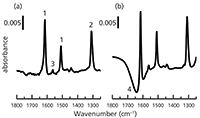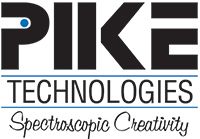Surface-Sensitive Spectroelectrochemistry with ATR-SEIRAS
Application Notebook
We monitor potential-induced changes at a Au film electrode using the ATR-SEIRAS sampling technique. Benefits are discussed.
Attenuated total reflectance surface-enhanced infrared absorption spectroscopy (ATR-SEIRAS) provides in situ surface-sensitive IR spectra of molecules at the electrode-solution interface. A Au thin film electrode is deposited on the reflecting plane of the ATR optic. Excitation of surface plasmon modes in the film provides up to 10-fold electric field enhancement at the interface, enhancing IR cross-sections of adsorbed species up to 100-fold. Controlling the applied potential on the film allows vibrational characterization of potential-induced changes. Such studies reveal fundamental details of electrochemical processes and inform the development of next generation energy and sensing solutions.
Experimental Conditions
The VeeMAX III with ATR and electrochemical cell option (PIKE Technologies, Madison WI) was used as the FT-IR sampling accessory. The electrochemical cell is designed to be easily modified to meet varied requirements in the field. We modified the cap of the VeeMAX III electrochemical cell to accept a Au coil counter electrode, a glass bubbler for Ar purging, an exhaust bubbler, and a Au bead electrode. The Au bead was pressed against the Au film to ensure potential control. In the cell body, a hole was bored to fit a reference electrode arm.

We sputtered a ca. 30 nm Au film electrode on a 60° angled Si ATR crystal. We then cycled the potential of the film in 50 mM KClO4 supporting electrolyte between -100 and +1100 mV versus Ag/AgCl. This cleans the film and textures the surface to improve SEIRAS intensity. The VeeMAX III was set to 60° to match the crystal face angle. FT-IR spectra were collected at 4 cm-1 resolution, 128 scans, and 40 kHz scanning velocity using an MCT detector.
Results
We used the potential-dependent adsorption of 4-methoxypyridine (MOP), a nanoparticle shape-directing ligand, as a test system. We collected a reference spectrum of supporting electrolyte, then a sample spectrum with 0.1 mM MOP, both at the open circuit potential. The result is shown in Figure 2a. We observe two strong ring vibrations (1) and the methoxy C-O-C asymmetric stretch (2). A third ring vibration (3) has its transition dipole moment (TDM) mostly parallel to the electrode-solution interface when adsorbed, so (3) is very weak. Only vibrations with their TDM normal to the interface are IR active. This confirms the surface sensitivity of the measurement.

Figure 2b reveals changes in interfacial composition upon potential changes. The negative absorbance band (4) represents loss of interfacial water. This band is absent in (a) because, at open circuit conditions, water adsorbs in a flat state on Au, rendering the H2O bending mode inactive in SEIRAS. We see also the characteristic MOP bands, which shows that we have potential control over the adsorption of MOP.
Conclusion
With PIKE's variable angle VeeMAX III ATR accessory and electrochemical cell, we have demonstrated a surface-sensitive technique which can resolve minute changes in interfacial composition.

PIKE Technologies
6125 Cottonwood Drive, Madison, WI 53719
tel. (608) 274-2721
Website: www.piketech.com
